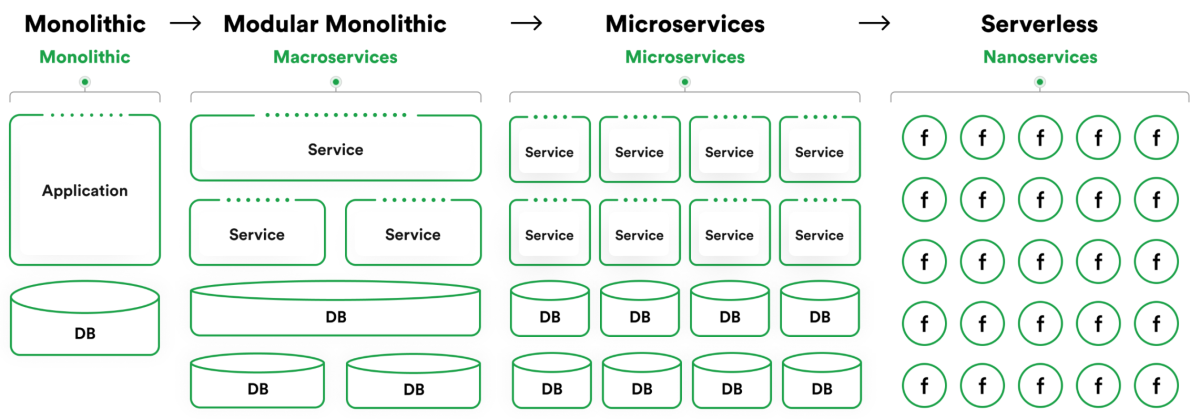
Digital Transformation Triggered by App Modernization: Best Practices and Considerations
Exploring the strategies and critical considerations for enterprises venturing on digital transformation journeys through application modernization.
According to recent statistics, roughly 4 out of 5 businesses already use microservices. Furthermore, industry trends indicate a growing interest in nanoservices, particularly in sectors where technological agility and system reliability are paramount, such as financial services and e-commerce.
This article provides practical guidelines designed to help you understand each architectural style, discussing its advantages, challenges, and suitability for various business contexts. By delving into the nuances of each architecture, we aim to equip technology leaders and developers with the knowledge to make informed decisions that align with their strategic goals and operational needs.
During the first phases of the software industry, monolithic architecture was the de facto standard for designing and deploying applications. All software application components are tightly integrated and compiled into a single codebase in a monolithic architecture. This setup simplifies the development process, especially for smaller teams and more straightforward applications, as it allows for a unified development environment where changes can be implemented rapidly and tested comprehensively.
The simplicity of deploying and managing a single application stack makes monoliths particularly appealing for startups and small-scale applications. Due to reduced complexity in the deployment pipeline, smaller projects often benefit from a reduction in initial development time when using a monolithic structure.
With all processes running in a single process space, monoliths can minimize latency, as no network calls or data format translations are needed between different services. This architectural benefit is crucial for applications requiring high-performance computing and real-time processing.
Since all components are within the same application, it simplifies the setup for development and testing environments, which can be an advantage during the early stages of an application’s lifecycle. Monolithic applications often experience a faster turnaround for debugging and testing compared to distributed architectures.
A monolithic approach ensures data consistency and integrity as it operates on a single database. This simplifies transaction management without the complexities of distributed systems, where data consistency can be a significant challenge.
As applications grow, scaling a monolithic application often means scaling the entire application rather than just the components that require more resources. This can lead to significant overhead and inefficiency. Monolithic architectures could lead to an increase in resource consumption during scaling operations for large-scale applications.
As the codebase grows, the complexity increases, making it challenging to implement new features quickly. The monolithic nature also means that any update requires redeploying the entire application, which can introduce risk and downtime.
Due to tight coupling, changes in one part of the system can affect other parts, leading to a higher risk of unintended consequences when updating code. This can also hinder the adoption of new technologies or frameworks, as the entire system may need significant refactoring to incorporate new changes.
Integrating new technologies or frameworks into a monolithic application becomes increasingly challenging as technology evolves. This often results in complete rewrites or significant modifications, which can be costly and time-consuming.
The limitations of monolithic architectures, particularly for larger, more complex systems, have paved the way for the adoption of microservices. Microservices architecture breaks down an application into a collection of smaller, independent modules developed, deployed, and managed individually. Each service in a microservices architecture typically implements a specific business function and communicates with other services via well-defined APIs. This architectural style aligns well with agile development principles and continuous delivery.
One of the most significant advantages of microservices is the ability to scale parts of an application independently. This allows for more efficient use of resources and better handling of varying loads. Companies that adopt microservices could see a reduction in scalability issues, particularly during peak usage times.
Microservices enable teams to develop, test, and deploy updates for individual components without impacting the entire system. This results in faster iteration cycles and a more dynamic response to market changes. A survey by DZone reported that 63% of enterprises observed quicker deployment times after transitioning to microservices.
By segregating services, failures in one application area are less likely to impact others, improving overall system resilience. Organizations leveraging microservices experience reduced system downtime due to improved fault isolation.
Microservices architecture allows different services to be written in other programming languages, use different data storage technologies, and be managed by other teams. This flexibility can lead to innovation and optimization of resources tailored to specific service needs.
Managing a distributed system of many small services introduces deployment, monitoring, and inter-service communications complexity.
Inter-service communication over networks can introduce latency, mainly if not correctly managed.
Ensuring data consistency across services can be challenging without careful design and robust infrastructure.
Each microservice might need its own database and transaction management, leading to increased overhead. This can also make integration and end-to-end testing more complex and resource intensive.
As architectural frameworks evolve, nanoservices have become a natural extension of microservices. Nanoservices push the boundaries of granularity by breaking down functionalities into tiny and more focused components. Each nanoservice performs a particular task, allowing for unparalleled specialization and modularity.
Nanoservices take modularity to the next level, offering precise scaling and resource allocation. This granularity allows for highly targeted updates and optimizations, potentially reducing the resources required for specific functionalities.
With such finely segregated functionalities, any failure is highly localized. This means that a failure in one nanoservice has minimal impact on the overall system, enhancing the application’s reliability and uptime.
Nanoservices empower developers to innovate within highly constrained scopes, offering a sandbox for new ideas and technologies. This freedom can lead to rapid testing and deployment of innovative solutions within an isolated environment, sparking excitement and creativity.
While nanoservices offer significant advantages, it’s crucial to understand and prepare for their challenges. The overhead associated with managing hundreds or even thousands of nanoservices can be substantial. From deployment and monitoring to troubleshooting and updates, operations become more complex. By gaining a comprehensive understanding of these challenges, you can feel prepared and confident in your transition to nanoservices.
The extreme division of services might lead to over-engineering, where the cost of managing many small components outweighs their benefits. Sometimes, the effort required to orchestrate and maintain many services can become counterproductive.
Each nanoservice might require individual configuration, deployment, and management strategies, which can complicate the architecture further. Issues such as increased network traffic, service discovery, and load balancing become more pronounced as the number of services grows.

Choosing the most suitable software architecture is a critical decision that can profoundly impact an organization’s efficiency, scalability, and future growth. The decision between monolithic, microservices, and nanoservices architectures is influenced by various factors, including application complexity, team size, deployment needs, and specific business requirements. Grasping these factors and their alignment with the characteristics of each architectural style is critical to achieving optimal performance and agility and empowering you to make informed decisions.
The complexity of the application often dictates the architectural approach. A monolithic architecture suffices for more straightforward applications, providing ease of deployment and management. However, complex applications with multiple business functions might benefit from a microservices architecture, which can handle different components independently. According to a survey by IBM, 70% of enterprises with complex application landscapes report better manageability and agility with microservices than monolithic approaches.
The size and expertise of the development team are also critical in choosing the exemplary architecture. Larger teams across different functions might find microservices beneficial as it allows them to work independently on various aspects of the application. Nanoservices, while offering even greater specialization, require highly skilled teams familiar with managing distributed systems.
Frequent updates and the ability to quickly scale specific parts of an application are vital considerations. Microservices offer the advantage of deploying and scaling services independently without affecting the entire application, making them suitable for dynamic environments that require continuous updates.
It is ideal for startups or smaller applications where the overhead of managing distributed systems is not justified. Monoliths simplify the deployment process and reduce the initial complexity, making them suitable for applications with stable features.
Best suited for medium to large enterprises that require robust scalability and flexibility. They are particularly advantageous for businesses that need to quickly adapt to changing market demands or those looking to scale specific parts of their application efficiently.
Appropriate for highly specialized applications requiring extreme scalability and fault isolation granularity. They are often used in high-stakes industries like financial services, where precision and system reliability are paramount.
As we look toward the future of software architecture, several emerging trends and technological advancements are shaping the landscape, promising to redefine how applications are designed, developed, and maintained. The need for greater efficiency, adaptability, and scalability in software systems drives the continuous evolution of architectural styles.
Serverless architectures are gaining traction for a reason. They liberate developers from the complexities of server management, allowing them to focus solely on writing code. This model, operating on a pay-as-you-go basis, is highly scalable and cost-effective, eliminating the overhead of managing servers. Such practical benefits are driving the popularity of serverless computing, promising a more efficient and streamlined development process.
Containers have revolutionized how applications are deployed and managed, providing a lightweight, portable, consistent environment for running applications. Containerization, especially when combined with orchestration tools like Kubernetes, enhances the scalability and reliability of applications across different environments.
Artificial Intelligence and Machine Learning are no longer just buzzwords. They are increasingly becoming integral parts of software architecture, driving automation, predictive analysis, and enhancing decision-making processes. These technologies are not replacing human skills, but rather augmenting them, optimizing operational tasks and creating more intelligent, responsive, adaptive systems.
With the explosion of IoT devices and the need for real-time processing, edge computing is becoming an essential part of architectural considerations. By processing data near the source rather than relying on a central data center, edge computing reduces latency and bandwidth use, enhancing the performance of applications dealing with real-time data.
As technology advances, the importance of conducting thorough technology assessments cannot be overstated. By evaluating your current and future software needs, you can choose the most appropriate architectural style that addresses today’s requirements and positions you for future growth and innovation.
To navigate these architectural decisions effectively, consider partnering with an expert provider. An experienced technology partner like rinf.tech can guide your journey from monoliths to microservices and onto nanoservices, ensuring your software architecture is robust, scalable, and perfectly tailored to your business objectives. Conduct your technology assessment today and take the first step towards a more flexible and efficient software infrastructure.

Exploring the strategies and critical considerations for enterprises venturing on digital transformation journeys through application modernization.

Exploring the essential aspects of a corporate Strategic Technology Assessment initiative, focusing on how we do it for our customers at rinf.tech.

When should businesses consider legacy application modernization, what benefits can an application modernization strategy bring, what alternatives to consider, and how to approach a modernization project.